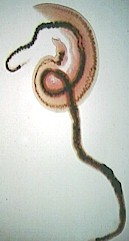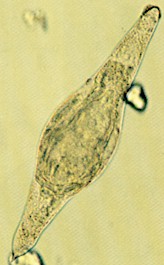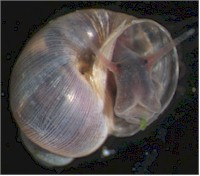Schistosoma, also called blood flukes,  is a genus of flatworms that has cattle, sheep and goats, as final hosts, but also other wild and domestic ruminants, horses, cats, and humans as well. They are found mainly in tropical and subtropical Asia and Africa, but also in South America and parts of Southern Europe. Abattoir studies in Tanzania showed up to 34% of investigates cattle to be infected. Another study in Ethiopia showed that up to 17% of the investigated cattle shed eggs of these worms.
is a genus of flatworms that has cattle, sheep and goats, as final hosts, but also other wild and domestic ruminants, horses, cats, and humans as well. They are found mainly in tropical and subtropical Asia and Africa, but also in South America and parts of Southern Europe. Abattoir studies in Tanzania showed up to 34% of investigates cattle to be infected. Another study in Ethiopia showed that up to 17% of the investigated cattle shed eggs of these worms.
The most relevant species for livestock and horses are: Schistosoma bovis, Schistosoma matthei, Schistosoma indicum, Schistosoma curassoni. Cats are affected by Schistosoma japonicum and Schistosoma reflexum.
The disease caused by Schistosoma spp is called schistosomiasis, bilharziosis or snail fever. It is also a serious human disease in endemic regions of Asia, Africa and South America. It is estimated that close to 200 million people are infected worldwide, mainly in Africa.
Are animals infected with Schistosoma species contagious for humans?
- NO. If livestock is infected with blood flukes, they are not directly contagious for humans, neither through contact, nor when consuming meat, milk or blood of contaminated animals, nor through the feces. The same applies to pets infected with blood flukes. Humans acquire schistosomiasis through exposure or ingestion to infective cercariae (see below under life cycle), not by ingesting adult flukes or their eggs. Most blood fluke species that infect livestock are not human parasites.
- However, aquatic immature stages (= cercariae, see life cycle below) of other Schistosoma species that are not pathogenic for humans can nevertheless penetrate the human skin and cause a skin inflammation (dermatitis) known as swimmer's itch, lake itch or cercarial dermatitis, which is a benign dermatitis: it will spontaneously recede about a week after infection.
Final location of Schistosoma spp
Predilection sites of blood flukes are the blood vessels, especially the portal and mesenteric veins.
Anatomy of Schistosoma spp

Blood flukes do not resemble most other fluke species. Instead of being flat and with an oval shape, they look very much like "normal" worms. Also unlike most other flukes Schistosoma is not hermaphroditic but bisexual, and males and females show a different form (sexual dimorphism).
Males are about 10 to 20 mm long and 1 to 2 mm thick, whereas females are 20 to 30 mm long and <1 mm thick, i.e. significantly longer and thinner than males. The oral and ventral suckers are rather small. Each male has a special structure along its body, the gynacophoric canal, where the adult female resides permanently. In fact it seems that females cannot mature in absence of the males.
As in other flukes the digestive system of Schistosoma is blind, i.e. it has no exit but ends in a blind branch, the cecum.
Schistosoma eggs have species-specific sizes (130-300x40-90 micrometers) and are oval to spindle-shaped, with or without spines.
Life cycle and biology of Schistosoma spp

Blood flukes have an indirect life cycle with freshwater snails as the intermediate hosts, mainly of the genus Bulinus.
The adult females lay eggs in the capillaries of the intestinal wall. The egg masses form abscesses that finally burst and release the eggs into the gut, which are transported outside with the host's feces. The abscesses usually heal spontaneously.
Once outside and in contact with water the eggs release small swimming larvae, the miracidia, which find a suitable snail and penetrate into its body. Inside the snail miracidia develop further during 1 to 4 months through two generations of sporocysts to asexually produce dozens of cercariae. Mature infective cercariae leave the snail through its respiratory hole. A single snail can release up to 3'000 cercariae.
Free-swimming cercariae actively search a final host. Their survival in the environment is limited to a few days. These infective cercariae actively penetrate through the skin of the host, or are ingested with contaminated water when grazing in marshes, swamps, and otherwise humid vegetation. Ingested cercariae penetrate the rumen.
Once inside the host's body they get into a blood vessel and start a species-specific migration (often passively transported with the blood) through various organs until they reach their preferred final locations where they complete development to adult flukes, copulate and start producing eggs. During this time they feed on red blood cells.
The prepatent period (i.e. time between infection with cercariae and start of egg production) is species-specific, e.g. about 7 weeks for Schistosoma matthei.
Harm caused by Schistosoma species, symptoms and diagnosis
Blood flukes are not excessively harmful for livestock. Most damage is due to the immature stages that penetrate the skin, or to the bursting of the egg filled abscesses in the gut. Immature flukes in the blood vessels feeding in red blood cells can cause anemia and compete for nutrients with the host's own tissues. They can also cause blood poisoning. Schistosoma bovis can also damage the gall bladder.
Most Schistosoma infections of livestock produce no clinical signs, even heavy infections. Intermittent diarrhea is sometimes observed, occasionally with blood and mucus. Constipation, anemia, weight loss and progressive weakness can happen as well.
In horses most infections remain asymptomatic. Problems may occasionaly occur in case of heavy burdens.
Diagnosis is confirmed through fecal examination for the presence of eggs, for some species also in urine.
Prevention and non-chemical control of Schistosoma
Where blood flukes are endemic, preventive measures are highly recommended to reduce the snail populations, the infection of pastures with infective stages, or the access to livestock to highly infested pastures.
Vector snails are aquatic and live in water (e.g. streams, lakes, pools, swamps, marshes, irrigation channels, ditches, ponds, watering holes, etc.) and are highly prolific. Whatever measures help keeping the pastures dry have to be encouraged to reduce the snail population e.g.:
- Ensuring an adequate drainage
- Building watering points on solid ground, without puddles
- Make unavoidable ditches or channels less attractive to the snails: making the borders steeper and/or cover them with concrete, eliminate the surrounding vegetation, drying them completely out periodically, etc.
If permanent humid environments cannot be eliminated, they have to be fenced to prevent livestock from grazing there.
In endemic regions preventative measures must include providing livestock with snail-free drinking water. These measures will prevent infections with other parasites that may appear at the same time, e.g. liver flukes (Fasciola hepatica, Fasciola gigantica) or stomach flukes (Paramphistomum spp).
There are so far no vaccines against blood flukes. To learn more about vaccines against parasites of livestock and pets click here.
Biological control of blood flukes (i.e. using their natural enemies) is so far not feasible.
You may be interested in an article in this site on medicinal plants against external and internal parasites.
Chemical control of Schistosoma
Chemical control of blood flukes in livestock is not easy and mostly uneconomic, because damage is usually not substantial.
The most effective anthelmintic is praziquantel, but this drug is often not available for use on livestock in many countries. However, sudden death of many flukes in the blood vessels can cause thrombosis in the hepatic vein, which can be fatal for the host. Therefore whatever anthelmintic treatment must aim at killing the flukes slowly.
Many other classic flukicides do not control rumen flukes, e.g. albendazole, clorsulon, netobimin, nitroxinil and triclabendazole. Neither macrocyclic lactones (e.g. ivermectin) nor levamisole are effective against any kind of flukes either.
Chemical control of the snails with molluscicides (i.e. snail killers) such as copper sulphate, sodium pentachlorophenate, niclosamide, etc. can make sense for very specific purposes, e.g. for treating places where livestock congregates (water holes, feeding areas, salt licks, shade trees, etc) to keep them free of snails, or if the drinking water is already contaminated with snails. But trying to eradicate snails from a property is hopeless and useless. It is virtually impossible to treat every place where they can survive and they reproduce extremely quickly. Cleaned pastures would become re-infested very fast. In addition, it would be too expensive and very harmful for the environment. In fact, such molluscicides are not approved in most countries.
| Ask your veterinary doctor! If available, follow more specific national or regional recommendations or regulations for Schistosoma control. |
Resistance of Schistosoma to anthelmintics
So far there are no reports on resistance of blood flukes to anthelmintics.
This means that if an anthelmintic fails to achieve the expected efficacy, chance is very high that it is not due to resistance. Either the product was used incorrectly or it was unsuited for the control of blood flukes. Incorrect use is the most frequent reason for failure of antiparasitic drugs.